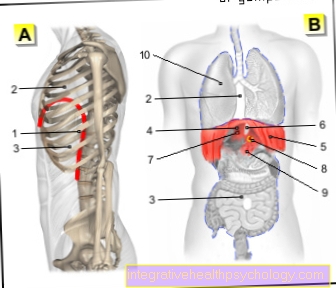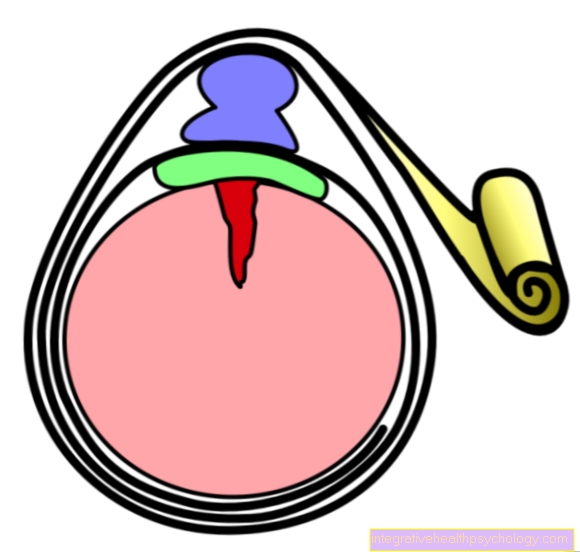Headache when coughing
introduction
Headaches that occur exclusively with coughing are also known as coughing headaches. A distinction must be made here between primary and secondary headache.
Primary cough headaches are counted among the rare forms of headache and are characterized by the fact that they do not occur in the context of other diseases, but rather in isolation. The situation is different with regard to secondary coughing headaches, which are caused by an underlying disease such as a cold. While secondary cough headaches in most cases subside with the underlying disease, primary cough headaches can last for several months to years.
The duration of individual headache attacks after coughing is a few seconds to minutes.

How does a headache come about when coughing?
How headaches arise when coughing is now well understood and has to do with an increase in intracranial pressure.
During the coughing process, the abdominal muscles contract, which increases the abdominal pressure (in the abdomen).
This leads to an increase in the central venous pressure, which is transmitted into the vessels of the head and here in turn leads to an increase in intracranial pressure, which results in headaches.
Since this mechanism is present in all people, the question remains why some patients react more sensitively to such an increase in pressure, in the sense of a primary headache, than others.
Recent studies have clarified this fact.
It has been shown that these patients often have an increased amount of nerve water (liquor) and thus have a fundamentally higher intracranial pressure.
If there is a further increase in the cough, the pain threshold of intracranial pressure is reached more quickly in these patients.
The causes for the increased nerve water volume are numerous and range from increased formation to restricted drainage.
Also read our article: Increased intracranial pressure - signs, causes, and treatment
How long do cough headaches last?
The duration of a cough headache varies widely.
While the individual attacks only last for a few seconds to minutes, the duration of the disease depends on the underlying cause. If the pain occurs as part of a respiratory tract infection, it usually only lasts until the infection has cured.
Primary cough headaches, on the other hand, can last for several years, but then often show spontaneous healing.
Therapy of cough headaches
In the treatment of cough headaches, the therapy of the underlying disease, if any, is always in the foreground.
For example, relieving coughs when you have a cold or using special nasal sprays as part of a sinus infection.
In the specific therapy for coughing headaches, it must be noted that acute therapy usually has no effect as the pain only lasts for a very short time.
The aim of treatment is therefore the prophylaxis of coughing headaches if they occur frequently.
On the one hand, the active ingredient, indomethacin, which belongs to the same class of substances as ibuprofen or ASA, is used here.
With a dosage of 25mg to 150mg, the drug should be taken three times a day in order to have a sufficient prophylactic effect.
In the case of prolonged use, a combination with an acid blocker (proton pump inhibitor) should be considered in order to prevent possible side effects in the gastrointestinal area.
As an alternative to indomethacin, the active ingredient acetazolamide can also be used.
If primary coughing headaches occur very frequently and persist for a long time, a lumbar puncture can still be performed, i.e. the removal of nerve fluid in order to lower the intracranial pressure for a certain time.
For details, see Indomethacin.
Can it also be a brain tumor?
Since brain tumors above a certain size can lead to an increase in intracranial pressure, it is possible that these lead to the development of coughing headaches.
This applies in particular to masses in the area of the posterior cranial fossa, as these can quickly lead to a disruption of the drainage of the nerve water and thus to an accumulation, which results in a further increase in pressure.
It must be noted, however, that brain tumors are a very rare cause of cough headache.
In addition, with a brain tumor there are other accompanying symptoms.
These include the so-called intracranial pressure signs, which, in addition to headaches, impaired consciousness, seizures, as well as nausea and vomiting.
Furthermore, neurological deficits can occur, which make themselves felt through dizziness, paralysis, visual and sensory disorders, balance disorders and unsteady gait.
As a result, it is very unlikely that coughing headaches will occur as part of a brain tumor disease.
Nevertheless, when diagnosing primary cough headache, imaging of the skull should always be carried out in order to exclude brain tumors or other serious diseases.
For a detailed explanation of brain tumor signs, see our article:
Signs of a brain tumor - you should know that
These are the accompanying symptoms
The accompanying symptoms that can occur with cough headaches initially depend on whether the headache is primary or secondary. While primary cough headaches usually have few accompanying symptoms, such as mild nausea, numerous other symptoms can occur with secondary headaches.
Since a cold and a sinus infection are the most common causes of secondary cough headaches, accompanying symptoms such as runny nose, a slight fever, a feeling of pressure over the sinuses or a sore throat are not uncommon.
fever
It is not uncommon for those affected to suffer from a fever in addition to the cough that leads to the headache, which suggests various causes.
The level of the fever can already be decisive in the differential diagnosis.
In the case of a slight fever, runny nose and cough, for example, it can be assumed that there is a common cold.
On the other hand, if the body temperature rises to values above 39 ° C, flu should be considered, especially in the cold seasons.
This is usually accompanied by a dry, tickly cough.
Pneumonia is another condition that can be considered if you have a high fever and cough.
A distinction between these two diseases is usually made by auscultating (listening to) the breath sounds and inquiring about other accompanying symptoms.
For more information, see Fever and headache.
You can read about other symptoms of a cold under:
Symptoms of a cold
Cold and runny nose
A cold and runny nose, in the sense of a sinus infection, are the most common causes of the secondary cough headache.
There is a slight increase in body temperature, a runny nose, cough and a general feeling of illness.
If you have a sinus infection, you will also experience pressure pain over the sinuses and mild to moderate headaches.
Again, the pain only occurs during coughing and subsides after a few minutes.
Everything you need to know about a headache during a cold can be found at:
Headache with a cold
This is how the diagnosis is made
The diagnosis of cough headaches consists first of all in differentiating them from other types of headache.
The information that the pain always occurs in isolation after the cough and only lasts for a short period is pioneering.
There is usually no photophobia, nausea or sensitivity to noise.
In addition, coughing headaches usually affect the entire head and are not dominant on one side.
Furthermore, a distinction must now be made between primary and secondary headaches, i.e. an underlying cause, such as a cold, must be searched for.
If no clear cause can be found, one speaks of primary headache.
As part of the diagnosis of this type of headache, imaging (CT or MRT) should always be carried out in order to exclude masses in the skull, which can also lead to increased intracranial pressure.
That is the prognosis
Overall, cough headaches have a very good prognosis.
This is especially true if an underlying infection can be identified that subsides within a few days and thus the pain also disappears. A somewhat worse prognosis, in terms of the duration of the illness, is recorded for primary cough headaches.
With the therapy options described above, however, these can usually be treated until they are symptom-free.






.jpg)




.jpg)

















